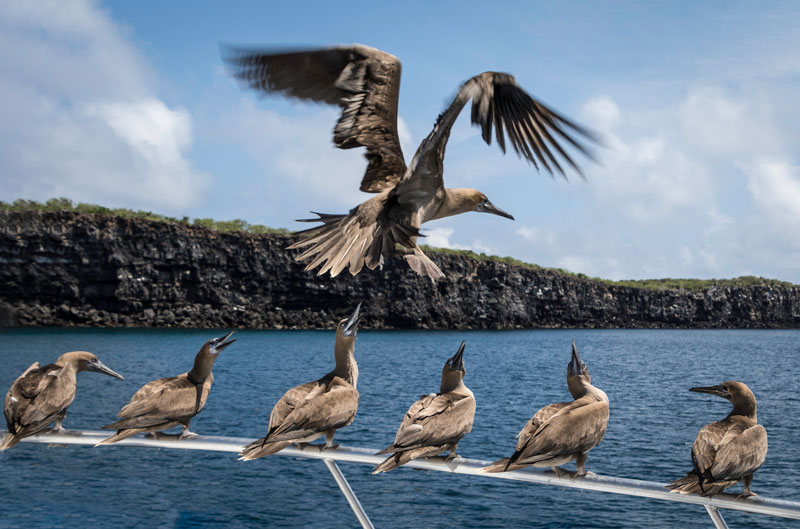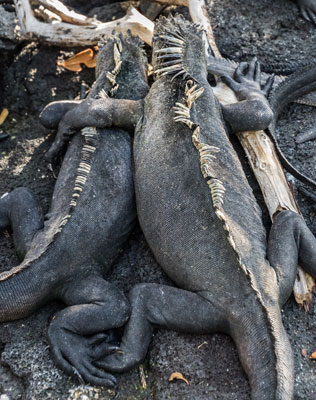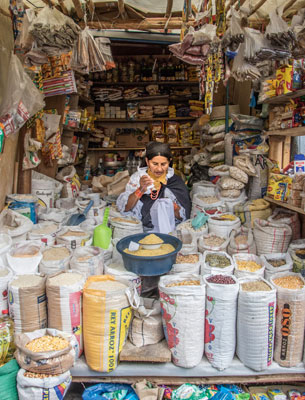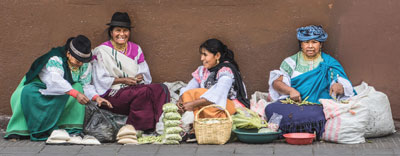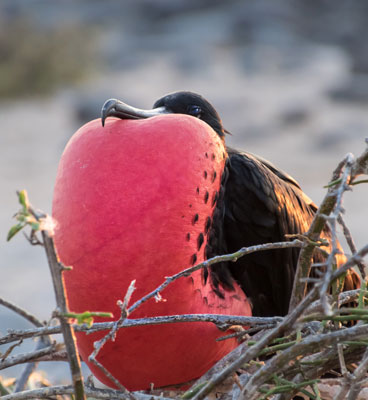On land and sea – discovering the natural and cultural treasures of Ecuador and the Galápagos Islands
This article appears on page 6 of the August 2016 issue.
“Careful! Don’t step on the sea lion.”
With those words, our guide Joed introduced us to the unique experience of observing wildlife in the Galápagos Islands.
Fifteen of us gingerly stepped around the large creature lying across our path as we threaded our way across North Seymour, the first island we visited on an 11-day tour aboard the 125-foot-long Tip Top IV, a luxurious yacht that was to be our home for the next 10 nights.
On our own in Quito
My husband, Steve, and I had decided on a January-February 2016 trip to the Galápagos after watching a program about some of the world’s special places that might be endangered by global climate change. I had noticed frequent ads in International Travel News for the tour operator Galapagos Travel (Aptos, CA; 800/969-9014, www.galapagostravel.com), so I gave them a call to find out about their tours. I soon learned that they offer a longer stay in the islands than most companies — 11 days as opposed to the four or seven days that seem to be the norm with other companies.
The tour package we chose covered 14 days of travel. We were met upon our arrival in Quito, Ecuador, and transferred to Hotel Mercure Alameda, a 4-star property conveniently located in this capital city.
Our first full day was free for us to explore Quito. The travel agency offered day tours for an extra fee, but we decided to explore on our own.
We took a $5 taxi ride to the Teleférico, a gondola lift that takes visitors to the top of the Pichincha Volcano, which rises behind the city. At 13,300 feet, we disembarked for a magnificent view of the city and the surrounding countryside. We luckily had a clear day, though a noticeable haze of pollution hung over the city.
Later that afternoon we took another $5 cab ride to the Old Town, where we walked up and down the narrow streets looking for a place to have dinner. However, we were looking in the wrong places, the narrow cobblestone side streets. It turns out there are many restaurants and shops in the colonnaded area that borders the main square.
After catching a cab back to the hotel, we decided just to eat there. (The concierge did caution us to take taxis if we went out at night rather than taking the bus or walking.)
Heading out
The next morning, we gathered in the lobby at 4:30 to meet our fellow travelers and transfer to the Quito airport for our 6:55 a.m. flight to Baltra, one of two airports in the Galápagos. (Quito is about a 75-minute ride from its own airport, hence our very early transfer.)
We found our 13 travel companions to be delightful, and we were especially lucky to have three marine biologists in the group.
We landed on time in Baltra, and after a short bus ride we were on the yacht and on our way.
The Tip Top IV had cabins above the main deck with large windows and cabins below deck that had high portholes. The travel agency told us that the rooms below were more stable, but we chose one with windows and were glad we did. Cabins were allotted on a first-come, first-served basis, depending on when you signed up for the trip.
After lunch and a safety information meeting, where we learned emergency procedures and protocol for shipboard living, we literally jumped right into our tour of the islands with a snorkeling session.
Our first landing took place that very afternoon on the aforementioned North Seymour Island. It took a while to get accustomed to the fact that the birds and animals simply didn’t care that we were there. They ignored us. Of course, we were told not to touch any wildlife, but trying to stay the required six feet away wasn’t easy, as creatures were right in the walking path.
We saw and photographed not only Galápagos sea lions but magnificent frigatebirds, great frigatebirds, lava lizards, land iguanas and blue-footed boobies. Many of the male magnificent frigates displayed the inflated bright-red gular sacs with which they were attempting to attract females to their nests.
Stellar staff
That evening, back on board, we met the crew and ate the first of many excellent dinners prepared by the ship’s chef. On this particular tour, we were accompanied by not only our naturalist guide, Joed, but his cousin Daniel Fitter, a professional photographer and author who grew up on the islands.
Every evening after dinner, Joed treated us to a preview of what the next day’s sightseeing would be, then Daniel would give a talk about some aspect of the Galápagos, emphasizing the history and geology of the islands.
Since his father established and ran the first yacht charter operation in the islands, Daniel was well versed in much of the human history as well. It was great fun to hear some of the “off the record” tales of the early inhabitants and the personal stories of Daniel and his family.
With Daniel as one of our guides, this tour was especially suited for photographers. He and Joed warned us the first night that this would be “a cross between paradise and boot camp.”
We were awakened at 5 each morning. Breakfast was served at 5:30, and at 6:15 we boarded the pangas (small inflated motorboats) to ferry to the island of the day. The idea was to be on land by sunrise.
Getting this early start meant that (1) we had the best light for photography, (2) we were there when the animals were most active, (3) we were there before most of the other tour groups and (4) we did our trekking before the heat of the day. Considering the equatorial sun, number 4 was no small matter.
Life on board
Our days quickly settled into a routine. After each day’s early-morning excursion, we returned to the yacht mid-morning for a snack and either changed into snorkeling gear or went for a panga ride. Lunch was served on board at 12:30, then we had an hour or so of rest before once again assembling for a snorkeling or panga excursion.
A late-afternoon island landing was next. Visitors were required to be off the islands by sunset, so dinner was usually scheduled for 7:00, followed by our nightly lecture and a preview of the next day. We would fall into bed exhausted by 9 p.m.
The yacht had several lovely common areas, both indoors and on deck, for those who wished to relax.
Since most of the snorkeling was in deep water, many of us wore lightly inflated vests to help with buoyancy. The water was not as clear as it is in the Bahamas or Hawaii, so photography was not very enticing, but we can say we swam with the sharks!
The panga rides often proved very exciting. One morning we spotted three young orcas chasing a mola mola. Disoriented, the sunfish tried to shelter near our pangas, and the orcas proceeded to dive under our little boats in search of their prey! For over 30 minutes we excitedly sprang from side to side, trying to get photographs of these amazing creatures.
Being prepared
We usually had two landings a day, in the early morning and late afternoon. Some were dry landings, where we stepped onto a dock, and others were wet landings, meaning we slid out of the pangas into the surf.
One of the best pieces of advice we got before we left home was to get closed-toed water sandals. They were perfect for wet landings, and because they had closed toes, they also worked for the hiking over rocks and lava that many of the trails required.
Another bit of handy advice was to pack long-sleeved shirts to go over our swimsuits. The equatorial sun can burn you very quickly! Fortunately, all of us had sunscreen, hats and long sleeves, so no one got badly burned.
Steve and I also went to the travel clinic at home to get a prescription for Cipro, in case of travelers’ diarrhea, and we were glad we did.
Some passengers took medicine for seasickness. Steve and I had never been overnight on a ship before, but neither of us had any problem with seasickness. The ocean was generally fairly calm.
During the day we would be anchored near that day’s island of choice. At night, the ship would motor four or five hours to our next destination. I actually enjoyed being rocked to sleep.
Amazing wildlife
Our itinerary allowed us to visit North Seymour, Genovesa and Santiago, with a number of landings on Isabela, Fernandina, Floreana, Santa Cruz, Española, San Cristóbal and Mosquera. Every island was different — different topography, climate, flora and geology. I had no idea there were so many types of lava formations! We learned to tell the difference between flows that had cooled quickly, those that had settled slowly and those made up of compacted ash.
Over the course of our voyage, we photographed sea turtles swimming; giant tortoises challenging each other; Nazca boobies mating, nesting and raising their young; sea lion pups nursing and playing; night herons hunting Sally Lightfoot crabs, and marine iguanas sunning themselves, as well as land iguanas, red- and blue-footed boobies, flightless cormorants, penguins, spotted rays, flamingos, the many varieties of finches and numerous other birds, lizards, insects and marine life.
On the eighth day of our voyage we visited the town of Puerto Ayora, where the Darwin Research Station is located. This was the only part of the trip that I found disappointing. I was anxious to see the famous saddleback tortoises, but they were enclosed by a stone wall, so viewing was limited.
The day was very hot, and the walk to the preserve was long and tiring. After having experienced so many of the Galápagos tortoises up close on the trails, the preserve for the saddlebacks was a letdown.
A few details
We could not have had better guides on our tour of the Galápagos Islands. Both men were delightful companions as well as knowledgeable and personable. They did not hurry us along but were willing to spend time explaining things and letting us enjoy observing and photographing the sights.
We all agreed that this was not a tour for those who merely want to check an item off their bucket list. This is a trip for travelers who are active, interested and engaged in learning about a fascinating and fragile environment.
The price for the 14-day tour was $6,100 per person plus $540 for round-trip airfare between Quito and the islands, a $100 entrance fee to the Galápagos National Park and money for tips for the crew and guide.
All meals and transport were provided except for lunch and dinner on our first day in Quito. Several side trips were available for purchase as well, either before or after the tour. Wetsuits and vests were also available for rent, but I had brought my own.
Snorkel gear was complimentary, as were all nonalcoholic beverages. Beer and wine each cost $5.
Otavalo excursion
Steve and I decided to do a side trip to Otavalo after our voyage, hiring a private guide recommended on TripAdvisor.com. Justo Raul (justoestevez@yahoo.com) gave us an excellent tour of Quito’s Old Town before driving us to our accommodations near Otavalo. He picked us up the next day for a tour of the area, with a special emphasis on the famous market at Otavalo.
His fee for the two days was $220.
The Otavalo market is world-renowned. Though we were not there on a Saturday, when animals are also on sale, there was quite enough to see on a weekday. Beautiful weavings, jewelry, hats, pottery, rugs and ponchos were on display as well as many types of food and crops.
I bought several weavings and necklaces. Bargaining is definitely allowed; at one stall I paid $5 for a table runner that was originally priced at $15, and I bought a poncho for $15 that I had seen in Quito for $30.
While in the Otavalo area, we stayed two nights at Hacienda Cusin, a restored 17th-century estate with cottages and beautiful gardens ($120 plus tax, including breakfast).
The hacienda arranged a day trip for us to take the Freedom Train. The round-trip journey from Ibarra to Salinas traversed many gorges and tunnels.
After arriving in Salinas, we were given a tour of the town and a cultural display by the Afro-Ecuadorian residents. We also learned about the salt-mining operation that was once the town’s livelihood. A portion of the $21 train fare goes to the residents of the town.
Since the Quito airport is as close to Otavalo as it is to Quito, we asked the hacienda to arrange a transfer for us to the airport for our flight home. The cost was $70 for the two of us.
Our flight was leaving at 12:40 a.m. and we were supposed to be at the airport two hours before the flight. However, Steve always wants to leave early when we are ready to leave for home, so we asked for the transfer to be ready 30 minutes earlier than the hacienda recommended. That turned out to be a good thing!
We had a flat tire on the way to the airport. Our driver frantically changed the tire on the side of the highway as Steve and I held our flashlights for him to see what he was doing.
We had a wonderful time in Ecuador. The people were friendly, the food was good, the climate was comfortable, and the wildlife was spectacular. We would definitely recommend Galapagos Travel, especially a voyage with Daniel Fitter.

